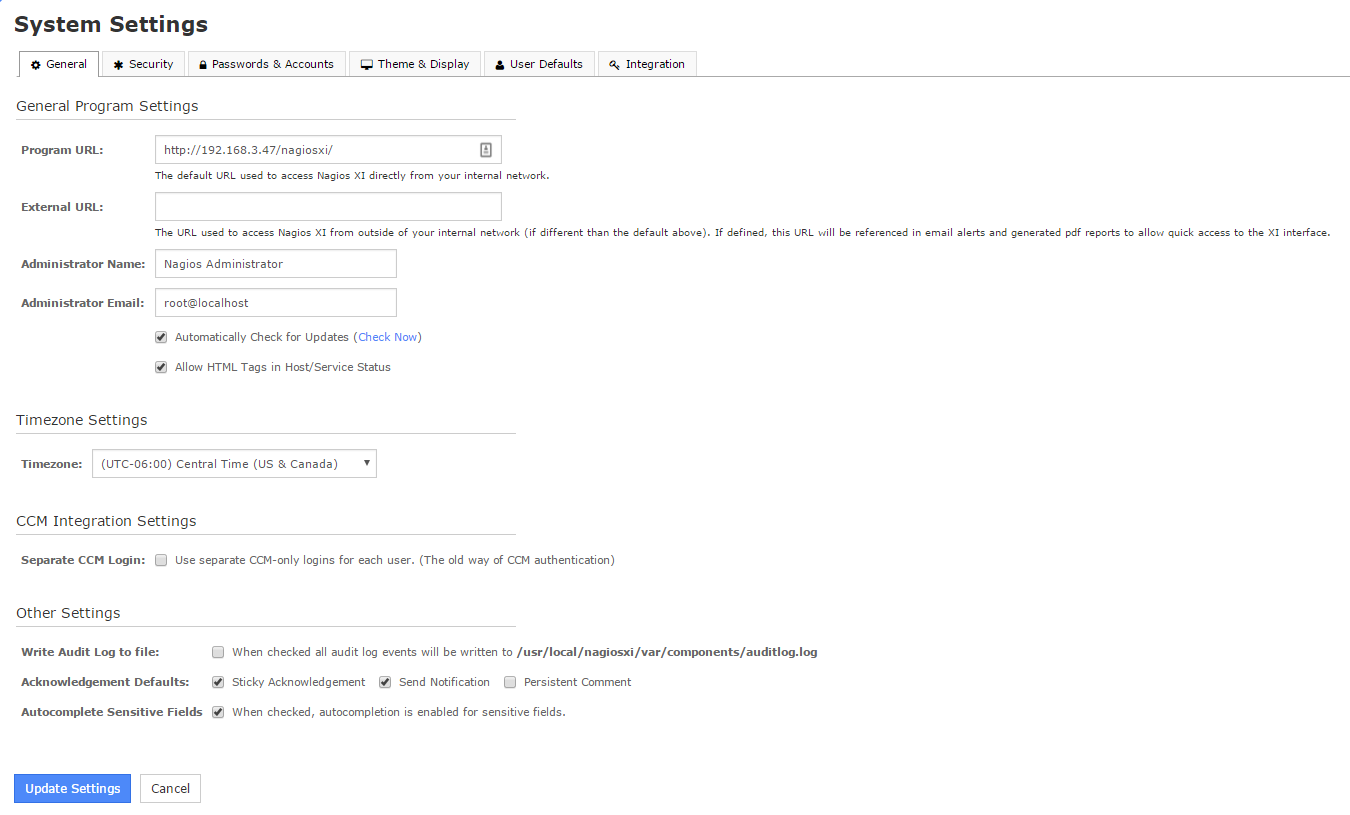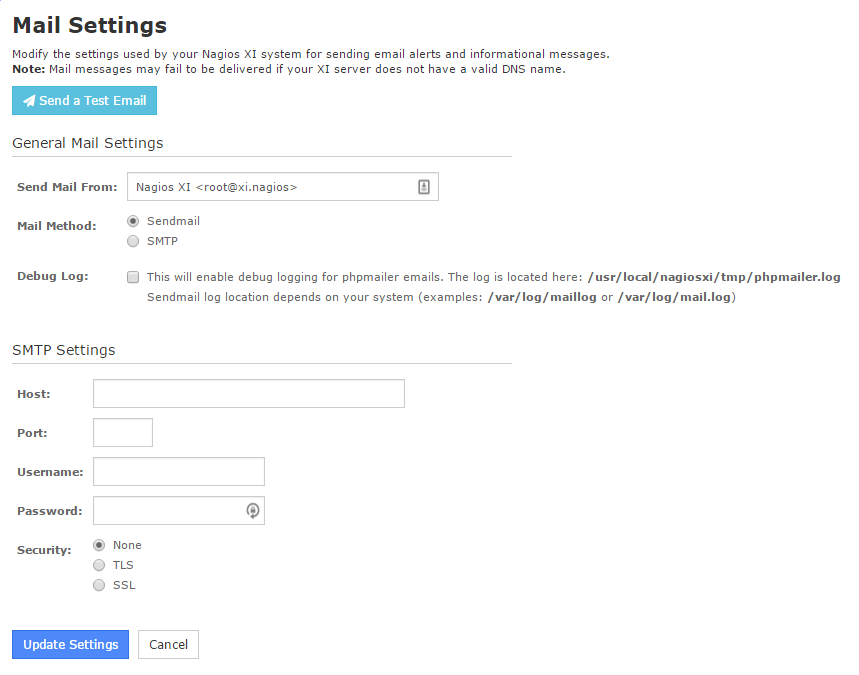Getting Started
Installation
- System Requirements
- Ports and Protocols
- Installation Options
- Using the Virtual Machine
- Installing Nagios XI with VMware Workstation
- Installing Nagios XI with VMware ESX vSphere
- Converting The VMware Image To VirtualBox
- Installing Nagios XI with Hyper-V
- Manual Installation
- Installing Nagios XI via RPM
- Installing Nagios XI In An Offline Environment
Updates
System Configuration
- Best Practices
- Initial Setup
- License Settings
- General Program Options
- Changing The XI System Time
- Customizing the XI Landing Page
- Email Settings
- Understanding Email Sending
- Configuring Email Notifications
- Inbound Email Commands
- Notification Escalations
- Scheduling Downtime
- SMS Alerting
- Twilio SMS Integration
- Setting Up Microsoft SMTP with OAuth 2.0
- Setting up Gmail SMTP With OAuth 2.0
- Discord Integration
- MultiTech MTR API Integration
- Slack Integration
- Using DUO 2FA
Agents
Monitoring Configuration
- Using Monitoring Wizards
- Using Auto-Discovery
- Bulk Host Import Wizard Usage
- Business Process Intelligence (BPI)
- Core Configuration Manager (CCM)
- Maintaining Manual Object Configuration Files
- Notification Variables
- Changing Host Alive Check
- Using the Deadpool
- Using the Generic Plugin Wizard
- Using the Negate Plugin
- Using NRDP With Nagios XI
- Understanding User Macros
- Understanding The User Macros Component
- Using The SNMP Walk Wizard
- Excluding Hosts And Hostgroups
- Log Monitoring with Swatch
- Monitoring Hosts Using SSH
- Monitoring Hosts Using NRPE
- Monitoring Linux Using NCPA
- Monitoring Linux Using NRPE (Legacy)
- Monitoring Linux Using SNMP
- Monitoring Active Directory with LDAP
- Monitoring AIX
- Monitoring Amazon EC2
- Monitoring Amazon S3
- Monitoring Apache ActiveMQ
- Monitoring Apache Tomcat
- Monitoring a Cassandra Database
- Monitoring a DHCP Server
- Monitoring DigitalOcean
- Monitoring DNS Queries
- Monitoring Docker Containers
- Monitoring Domain Expiration
- Monitoring FTP Servers
- Monitoring a Generic Device (Ping)
- Monitoring GlassFish
- Monitoring JBoss/WildFly
- Monitoring JMX
- Monitoring JSON APIs
- Monitoring Kubernetes
- Monitoring LDAP Servers
- Monitoring Linode
- Monitoring Nagios Log Server Queries
- Monitoring Mail Servers
- Monitoring Meraki Switches
- Monitoring MongoDB Servers & DBs
- Monitoring MySQL Servers & Queries
- Monitoring Nagiostats
- Monitoring A Nagios XI Server
- Monitoring OpenAI Usage
- Monitoring Oracle Databases
- Monitoring OSX
- Monitoring PostgreSQL
- Monitoring JetDirect Printers
- Monitoring Prometheus
- Monitoring Rackspace
- Monitoring RADIUS Servers
- Monitoring SLAs
- Monitoring SNMP OIDs
- Monitoring SNMP Traps
- Monitoring Solaris with NCPA
- Monitoring Switches and Routers
- Monitoring TCP/UDP Ports
- Monitoring TFTP Servers
- Monitoring VMware
- Monitoring WatchGuard
- Monitoring WebLogic
- Monitoring Websensor EM08
- Monitoring Websites
- Monitoring Website Defacement
- Monitoring XML APIs
- Monitoring Zabbix Agents
- Passive Monitoring
- Passive Monitoring
Monitoring Windows
- Using NCPA
- Using NSClient++
- Using SNMP
- Using WinRM
- Monitoring MS 365
- Monitoring Windows Event Logs
- Monitoring Microsoft Exchange
- Monitoring Hyper-V
- Adding Windows Disk Usage Checks
- Monitoring Microsoft SQL MSSQL
- Checking For Windows Updates
- Passive Monitoring with NRDS_Win
User Management
Visualizations
- XI Details Overview
- XI Dashboards
- XI Views
- XI Tools
- Generating Graphs
- Generating Reports
- Generating SLA Reports
- Using Capacity Planning
- Using the World Map
- Using NagVis
System Management
- Directory Structure
- Log Locations and Descriptions
- Backing Up And Restoring
- Boosting Performance
- Repairing Database
- Database Optimization
- Managing Remote Nagios XI Servers
Advanced Topics
- Nagios XI Architecture
- High Availability
- Migrating From Nagios Core to XI
- Configuring Core Contacts To Use XI's phpmailer SMTP Settings
- SNMP Trap Integration
- Distributed Monitoring
- Enabling NagVis Restart Actions
- Integrating Nagios Mod-Gearman
- Exporting the XI Configuration Database
- XI on Amazon EC2 Cloud
- Using Auto Deployment (NCPA)
- Automated Host Management
- Restarting a Linux/Windows Services with XI
- SSO with Microsoft Azure Active Directory
- Authenticating with Active Directory
- Configuring SSL with Nagios XI
- Using SSL with XI Active Directory
- Integrating Mod_Security With XI
- Introduction to Event Handlers
- Redundancy And Security Planning
Developer Tools
- Global Event Handlers
- Accessing and Using the REST API
- Configuring FTP on XI Servers
- Writing Custom Wizards
- Component Development
- Integrating autoIT with Nagios
- Checking Program Loadtime With autoIT
- Actions Component
- Contributing To Nagios Translations
Extending Nagios XI
Nagios Enterprises, LLC. All rights reserved.
System Configuration
Nagios XI - Best Practices
This document covers various “best practices” which can be applied to your Nagios XI server. It accompanies the presentation from the Nagios World Conference by Troy Lea.
This document is intended for use by Nagios XI Administrators as a guide to understand how to get the most out of Nagios XI. It covers a range of topics such as how to get the most out of XI, things you wish you knew, and configuration practices.
Initial Setup
Upon the initial login to Nagios XI, you will be asked to configure a few basic system settings, such as the administrator password and the internal URL of the web interface. Review the final section of the installation guide for your chosen method for full details on these settings.
Once the initial system configuration is complete, any of these options can be re-configured by accessing the Admin panel, under the System Configuration menu, which is located on the left side of the interface.

License Settings
The Admin > System Config> License Information page allows you to update and view your current licensing information for Nagios XI.

Activating Your Nagios XI License
This document describes how to activate your Nagios XI license key. License activation is required for Nagios XI 2011.
General Program Options
To configure general settings for the Nagios XI interface, login as the administrator and select the
Admin link on the top menu bar. This will bring up the Admin dashboard, along with
all of the administrative links on the left menu. To access any of the general program options, select
the appropriate link under the System Configuration menu on the left side of the page.

Changing The XI System Time
This document describes how to change the system date, time, and timezone on the Nagios XI virtual machine, or a physical server running CentOS. It is intended for use by Nagios XI Administrators.
Customizing The XI Landing Page
This document describes how to customize the landing page that users see when they initially login to the Nagios® XI™ web interface. One of the benefits of Nagios XI is the flexibility to customize the information users see in the web interface. Customizing the landing (home) page within Nagios XI will allow users to get the most important information as soon as they log into Nagios XI.
Customizing The Landing Page - XI 2026
Email Settings
To modify the settings used by your Nagios XI system for sending email alerts and informational messages, navigate to Admin > System Config > Email Settings. Note: Mail messages may fail to be delivered if your XI server does not have a valid DNS name.

Understanding Email Sending
This document describes how Nagios XI sends emails and explains how to configure your email settings. Nagios XI uses email to send notifications as well as for sending reports.
This document is intended for use by Nagios Administrators who want to understand in detail how emails are sent by Nagios XI.
Configuring Email Notifications
This document describes how to configure and manage Email notifications within Nagios XI. It is intended for use by Nagios XI Administrators who are interested in integrating Email notifications into their Nagios XI monitoring environment. From the less experienced, to the Advanced admin.
Inbound Email Commands
This document describes the inbound email commands that are accepted by Nagios XI when it receives an email response to a notification.
This document is intended for use by Nagios Users who want to respond to incidents by email.
XI Notification Escalations
This document describes how to setup host and service escalations in Nagios XI. Escalations happen when a problem is not resolved for a host or service in a specified response time. When this occurs, notifications are sent to another level of contacts so issues are not overlooked. Escalations provide a way to notify the appropriate people of issues and make sure that issues receive the proper visibility and are resolved.
Scheduling Downtime
The purpose of this document is to show how you can schedule downtime for a service, host, hostgroup, or servicegroup within Nagios XI. Scheduling downtime is an effective way to prevent unnecessary or unwanted notifications from being received during a period of expected service interruption.
This document is designed for Nagios administrators interested in preventing unnecessary notifications during periods of expected service interruption.
Setting SMS Alerts in Nagios XI
This document describes how to setup SMS alerts and how to manage mobile carriers in Nagios XI. Notifications by SMS must be enabled per user in Nagios XI. Receiving SMS alerts allow users to get updates about their Nagios XI system via their mobile phone.
Nagios XI – Twilio SMS Integration
This document describes how to integrate Twilio component with Nagios XI for notification. The Twilio SMS component provides outbound SMS notifications from Nagios XI, thereby increasing the flexibility, reliability and dependability of receiving critical alerts and notifications.
This document is intended for use by Nagios Administrators who wish to integrate Twilio with Nagios XI to receive SMS alerts without using an email setup.
Setting Up Microsoft SMTP with OAuth 2.0
Note: This feature requires XI 5.10 or later.
This document describes how to setup OAuth 2.0 authentication for SMTP with Microsoft services such as Microsoft 365.
This document is intended for use by Nagios Administrators who want to use a Microsoft account to send emails out of Nagios XI.
Setting up Gmail SMTP With OAuth 2.0
Note: This feature requires XI 5.10 or later.
This document describes how to setup OAuth 2.0 authentication for SMTP with Google services such as Gmail.
This document is intended for use by Nagios Administrators who want to use a Gmail account to send emails out of Nagios XI.
Setting Up Discord Notifications with Nagios XI
This document describes how to set up Discord notifications with Nagios XI using the Discord Notifications Wizard.
How to Set Up Discord Notifications in Nagios XI - 2024 & 2026
Nagios XI – MultiTech MTR API Integration
This document describes how to integrate the MTR API found on a MultiConnect® rCell Series Router from MultiTech with Nagios XI. It will work with Nagios XI version 5.5 and newer. Nagios XI uses this API to send text notifications to recipients.
This document is intended for use by Nagios Administrators experienced with installing and configuring network devices.
Integrating Nagios XI with Slack
This documentation is a guide to integrating Nagios XI notifications with Slack channels using the built-in Slack Notifications Configuration Wizard.
Slack Notification Setup in Nagios XI 2024 & 2026
(Legacy) This documentation is a guide to integrating Nagios XI 5 notifications with a Slack channel. As of XI 2024R1, the Slack Notifications Wizard provides a significantly simpler method.
Nagios XI – Using DUO Two Factor Authentication
This document describes how to configure Nagios XI to use DUO for two factor authentication (2FA). Nagios XI already provides email 2FA however DUO can be used instead, this makes 2FA more accessible on more devices.
This document is intended for use by Nagios Administrators that need to configure DUO on Nagios XI.